| Message
From The Dean
Focus
on Technology Transfer
By
Cam E. Enarson,
M.D., M.B.A.,
Dean, Creighton School of Medicine
Vice President for Health Sciences
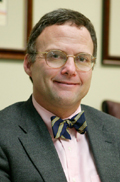 The
Creighton University School of Medicine is connected to the
world around us in many ways. An important but sometimes overlooked
connection occurs in the University’s Office of Technology
Transfer. The
Creighton University School of Medicine is connected to the
world around us in many ways. An important but sometimes overlooked
connection occurs in the University’s Office of Technology
Transfer.
This office offers our faculty expert guidance and support
for transferring knowledge and discovery into usable products.
Director Lee Fenicle and Associate Director Mary Ann Wendland
can help faculty researchers determine whether a discovery
is truly novel, how to protect new ideas and discoveries through
copyrights and patents, and then license the rights to develop
and commercialize.
Creighton’s Office of Technology Transfer has come a
long way in the past decade. Consider the following:
- During
the 2006-2007 fiscal year ending June 30, the office executed
five licenses and issued five licenses, 17 invention disclosures,
and 12 new patent applications, and one patent.
- Licensing
revenue totaled nearly $353,000 in 2006-2007, a 31 percent
increase from the previous year.
- Some
of the exciting Creighton discoveries the office is working
on include a novel variant of a human estrogen receptor
that shows promise in the treatment of breast cancer, a
genetic mutation that causes high bone mass, and several
discoveries that would aid in the identification of drug-resistant
bacteria.
The School
of Medicine accounts for about 90 percent of the Office of
Technology Transfer’s activity. I want to thank Lee
Fenicle and Mary Ann Wendland for their energy, expertise
and commitment in managing the intellectual resources of Creighton
for the benefit of the University, the School of Medicine,
the business community, and the world around us.
Technology
Transfer
Where
“Eureka” Meets Opportunity
By Lee Fenicle, M.Ed.
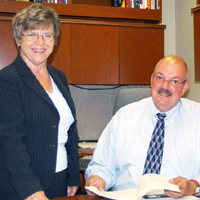
Mary
Ann Wendland and Lee Fenicle. |
|
If you
are a researcher, I have an important message for you.
Do you think you have discovered something new – a laboratory
tool, a novel treatment for heart disease, or a finding that
has no practical application in the foreseeable future? Your
first step should be to contact Creighton’s Office of
Technology Transfer.
The time to meet with us is before you write a paper or present
your findings at a conference. If you publish before you protect
your discovery, you lose your right to patent in most parts
of the world outside the United States.
Our office will do the research to determine whether your
discovery is something new that needs to be protected by a
patent or copyright. If your invention shows promise commercially,
we will contact potential industry partners who have the financial
resources to transfer that knowledge to the public arena.
Academic technology-transfer programs have been responsible
for bringing to the marketplace such diverse products as Tamoxifen,
nicotine patches, and the V-chip, which allows parents to
block offensive television programs.
The transfer of academic discovery to the marketplace is a
win-win for everyone. Both the University and the faculty
member share in licensing and royalty fees. If an invention
or idea becomes a commercial success, it can be an economic
benefit to the local community in the form of new businesses
and jobs. Additionally, an active technology transfer program
helps enhance a university’s research reputation, attract
and retain talented faculty, and encourage new grants and
donations.
I encourage you to use us as a resource. No finding is too
large or too small for the Office of Technology Transfer to
review.
Back
to Contents
Appointments
Lanspa,
Kennebrew Assume New Roles
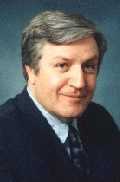 Stanette
Kennebrew, M.B.A., J.D., and Stephen J. Lanspa, M.D., have
assumed expanded roles in the Creighton University School
of Medicine. The appointments took effect July 1. Stanette
Kennebrew, M.B.A., J.D., and Stephen J. Lanspa, M.D., have
assumed expanded roles in the Creighton University School
of Medicine. The appointments took effect July 1.
Kennebrew joined the School of Medicine in 1998 as associate
dean for finance and administration. In her new position as
senior associate dean for finance and administration, she
will assume a greater leadership role within the school.
Lanspa’s new position is senior associate dean for academic
and clinical affairs. Lanspa joined Creighton’s faculty
in 1984. Most recently, he was associate dean for clinical
affairs. In his new position, he will oversee all academic
and clinical affairs for the School of Medicine to facilitate
better integration of the two areas. He will continue to serve
as president of Creighton Medical Associates.
Loggie
Named to Endowed Chair
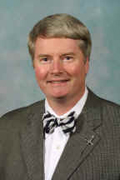 Brian
Loggie, M.D., has been named holder of The Dr. Harold J. Bonnstetter
Endowed Chair in Preventive Medicine at Creighton University
School of Medicine. Brian
Loggie, M.D., has been named holder of The Dr. Harold J. Bonnstetter
Endowed Chair in Preventive Medicine at Creighton University
School of Medicine.
The appointment was announced at the School of Medicine’s
spring faculty meeting. The chair is named after the late
Harold Bonnstetter, who earned his medical degree from Creighton
in 1931.
Loggie, a professor of surgery, joined the Creighton School
of Medicine in 2002 and serves as chief of the Division of
Surgical Oncology, which he founded. He also directs Creighton’s
Cancer Biology Program, a component of the institution’s
state-supported Cancer and Smoking Disease Research Program.
A renowned surgeon, Loggie is particularly known for his treatment
of rare, cancerous conditions. Patients around the world have
come to Creighton University Medical Center to be treated
by him for pseudomyxoma peritonei, peritoneal mesothelioma,
appendix tumors and other cancers. Since 2001, Loggie has
been elected by his peers for inclusion in “Best Doctors
in America.”
Back
to Contents
In
the News
Creighton
Study: Vitamin D Reduces Cancer Risk
Most Americans and others are not taking enough vitamin D,
a fact that may put them at significant risk for developing
cancer, according to a landmark study conducted by Creighton
University.
The four-year, randomized study followed 1,179 healthy, postmenopausal
women from rural eastern Nebraska. Participants taking calcium,
as well as a quantity of vitamin D3 nearly three times the
U.S. government’s Recommended Dietary Allowance (RDA)
for middle-age adults, showed a dramatic 60 percent or greater
reduction in cancer risk than women who did not get the vitamin.
The results of the study, conducted between 2000 and 2005,
were reported in the June 8 online edition of the American
Journal of Clinical Nutrition. More than 400 news outlets
worldwide reported on the story, and Creighton researchers
were interviewed by the Associated Press, Reuters, U.S. News
& World Report, Los Angeles Times, ABC News, Fox News
and others.
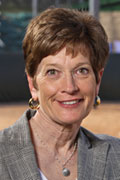 “The
findings are very exciting. They confirm what a number of
vitamin D proponents have suspected for some time but that,
until now, have not been substantiated through clinical trial,”
said principal investigator Joan Lappe, Ph.D., R.N., Creighton
professor of medicine and holder of the Criss/Beirne Endowed
Chair in the School of Nursing. “Vitamin D is a critical
tool in fighting cancer as well as many other diseases.” “The
findings are very exciting. They confirm what a number of
vitamin D proponents have suspected for some time but that,
until now, have not been substantiated through clinical trial,”
said principal investigator Joan Lappe, Ph.D., R.N., Creighton
professor of medicine and holder of the Criss/Beirne Endowed
Chair in the School of Nursing. “Vitamin D is a critical
tool in fighting cancer as well as many other diseases.”
Other Creighton researchers involved in the study included
Robert Recker, M.D.; Robert Heaney, M.D.; Dianne Travers-Gustafson,
M.S.; K. Michael Davies, Ph.D., and Gleb Haynatzki, Ph.D.
Research participants were all 55 years and older and free
of known cancers for at least 10 years prior to entering the
Creighton study. Subjects were randomly assigned to take daily
dosages of 1,400-1,500 mg supplemental calcium, 1,400-1,500
mg supplemental calcium plus 1,100 IU of vitamin D3, or placebos.
National Institutes of Health funded the study.
Over the course of four years, women in the calcium/vitamin
D3 group experienced a 60 percent decrease in their cancer
risk over the group taking placebos.
On the premise that some women entered the study with undiagnosed
cancers, researchers then eliminated the first-year results
and looked at the last three years of the study. When they
did that, the results became even more dramatic with the calcium/vitamin
D3 group showing a startling 77 percent cancer-risk reduction.
In the three-year analysis, there was no statistically significant
difference in cancer incidence between participants taking
placebos and those taking just calcium supplements.
Through the course of the study, 50 participants developed
nonskin cancers, including breast, colon, lung and other cancers.
Lappe said further studies are needed to determine whether
the Creighton research results apply to other populations,
including men, women of all ages, and different ethnic groups.
While the study was open to all ethnic groups, all participants
were Caucasian, she noted.
There is a growing body of evidence that a higher intake of
vitamin D may be helpful in the prevention and treatment of
cancer, high blood pressure, fibromyalgia, diabetes mellitus,
multiple sclerosis, rheumatoid arthritis and other diseases.
Humans make their own vitamin D3 when they are exposed to
sunlight. In fact, only 10-15 minutes a day in a bright summer
sun creates large amounts of the vitamin, Lappe said. However,
people need to exercise caution since the sun’s ultraviolet
B rays also can cause skin cancer; sunscreen blocks most vitamin
D production.
In addition, the latitude at which you live and your ancestry
also influence your body’s ability to convert sunlight
into vitamin D. People with dark skin have more difficulty
making the vitamin. Persons living at latitudes north of the
37th parallel – Omaha is near the 41st parallel –
cannot get their vitamin D naturally during the winter months
because of the sun’s angle.
Experts generally agree that the RDA for vitamin D needs to
be increased substantially, but there is debate about the
amount. Supplements are available in two forms – vitamin
D2 and vitamin D3. Creighton researchers recommend vitamin
D3 , because it is more active and thus more effective in
humans.
The current RDA recommendations for vitamin D are 200 IU/d,
birth-age 50; 400 IU/d, 50-70 years; and 600 IU/d, 70 years
and older.
Lynch
Helps Identify Mutation Linked with CLL
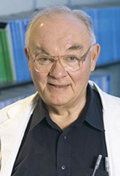 Henry Lynch, M.D., professor of medicine and director of Creighton’s
Hereditary Cancer Center, was co-investigator for a study
in which researchers discovered the first inherited gene mutation
that increases a person’s risk for chronic lymphocytic
leukemia (CLL). The findings, reported in the June 1 issue
of the journal Cell, could help identify people at
risk of chronic leukemia as well as new treatments for the
disease. Lynch identified the family examined by the research
team.
Henry Lynch, M.D., professor of medicine and director of Creighton’s
Hereditary Cancer Center, was co-investigator for a study
in which researchers discovered the first inherited gene mutation
that increases a person’s risk for chronic lymphocytic
leukemia (CLL). The findings, reported in the June 1 issue
of the journal Cell, could help identify people at
risk of chronic leukemia as well as new treatments for the
disease. Lynch identified the family examined by the research
team.
CLL is one of the most common forms of leukemia. About 15,300
people in the United States are expected to be diagnosed with
CLL this year; it’s estimated that one in 10 cases is
genetic. CLL typically strikes people in their 50s, 60s, and
70s; men are at slightly greater risk than women.

Nuns Study Writes Book on Good Habits
In 1967, 168 Catholic nuns from the Omaha area met at Creighton
University to serve a higher cause. Another 24 joined them
10 years later. And, every five years, these women faithfully
returned to Creighton’s St. Joseph Hospital (now Creighton
University Medical Center) for eight days and nine nights.
But this was no spiritual journey. The women – representing
six mother houses and all between the ages of 35 and 45 when
they started – were participants in what would become
known as the Omaha Nuns Study.
On April 25, 32 of the original study participants, along
with many of the Creighton researchers, nurses and others
involved in the research, gathered to celebrate the 40th anniversary
of the study. The study was pivotal to our modern-day knowledge
about women’s bone health and osteoporosis.
Among the findings resulting from the Creighton research:
Healthy adult women in midlife require 1,200 milligrams of
calcium each day; and calcium absorption is influenced by
such factors as body size, vitamin D, estrogen levels, age,
race, calcium source and other nutrient interactions.
The event was reported on by the Omaha World-Herald,
Associated Press (AP), Catholic News Service and others. The
AP story ran in about 150 newspapers around the country.
Program
May Be Just What the Doctor Ordered
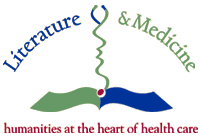 For
physician Thomas Tonniges it was a return of sorts to his
days as a liberal arts major. Except, this time around, his
classmates were 19 nurses, physicians, audiologists, researchers,
administrators and others at Boys Town National Research Hospital. For
physician Thomas Tonniges it was a return of sorts to his
days as a liberal arts major. Except, this time around, his
classmates were 19 nurses, physicians, audiologists, researchers,
administrators and others at Boys Town National Research Hospital.
Tonniges, director of the Boys Town Institute for Child Health
Improvement, and the others met between January and June as
part of Nebraska’s first Literature & Medicine:
Humanities at the Heart of Healthcare™ program.
The hospital offered the series in partnership with the Center
for Health Policy and Ethics (CHPE) at Creighton University
Medical Center.
The group delved into novels, short stories, essays, plays
and poetry that deal with children and families, obligations
within family structures, the welfare of children in general,
and caring for children under difficult circumstances. Readings
ranged from the Pulitzer Prize-winning play “Doubt,”
by John Patrick Shanley, to K.L. Goings’ novel, “Fat
Kid Rules the World.” Participants then met to discuss
the readings and offer their interpretations of them.
“Literature has been used as a means to help health
professionals reconnect to the human side of their practices
for many years as well as better understand the predicaments
faced by their patients,” said Amy Haddad, Ph.D., CHPE
director and Literature & Medicine group facilitator.
Literature & Medicine was developed by the Maine
Humanities Council. The Nebraska Humanities Council funded
the Boys Town/Creighton collaboration.
Back
to Contents
Research
Neuroscientist
Receives Major NIMH Grant
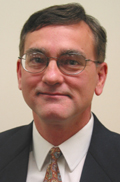 The National Institute of Mental Health (NIMH) has awarded
Kevin Happe, Ph.D., Creighton assistant professor of psychiatry,
a three-year, $740,000 research grant.
The National Institute of Mental Health (NIMH) has awarded
Kevin Happe, Ph.D., Creighton assistant professor of psychiatry,
a three-year, $740,000 research grant.
Happe will study how alpha-2 adrenergic receptors in the central
nervous system are affected in clinical depression and their
role in treatment with antidepressant drugs.
Among other things, the study may help determine how antidepressants
can more rapidly and effectively relieve depression. On average,
most antidepressants currently must be taken from three weeks
to two months before a patient shows improvement.
Frederick Petty, Ph.D., M.D., Creighton vice chair for research
and professor of psychiatry, and researchers from University
of Nebraska Medical Center and University of Nebraska-Lincoln
are study co-investigators.
Back
to Contents
Briefly
Noted
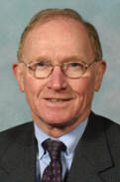 O’Brien
Named to Building Bright Futures O’Brien
Named to Building Bright Futures
Richard O’Brien, M.D., a professor at the Center for
Health Policy and Ethics, has been named to Building Bright
Futures, an Omaha community-wide initiative to support low-income
children from birth through college. O’Brien will serve
as vice chair of the “Addressing Adolescent Behavioral
Health Task Force.”
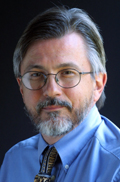 Lenosky
Named Association President Lenosky
Named Association President
Chuck Lenosky, director of learning environments and senior
project manager for health sciences in the Division of Information
Technology, has been named president of the Health and Science
Communications Association (HeSCA).
HeSCA’s mission is to advance an international community
of professionals dedicated to promoting excellence in health
and science communications through leadership, education,
and the application of technology.
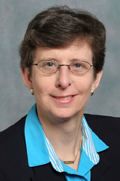 Sonnino’s
Photos Published Sonnino’s
Photos Published
Photographs taken by Roberta E. Sonnino, M.D., associate dean
for academic and faculty affairs for the School of Medicine,
are featured in Journey to Authenticity: Voices of Chief
Residents, published by the Accreditation Council on
Graduate Medical Education.
The 127-page, four-color, hardcover book includes interviews
with 20 chief residents, who discuss why they chose careers
in medicine, what drew them to their specialties, and how
they grew and changed during their residencies.
The text is accompanied by Sonnino’s photographs, which
show the residents as they go about their rounds, treat patients,
and teach junior residents. Residents featured include Sam
Caughron, M.D., and Cliff Perez, M.D., former Creighton chief
residents in pathology and surgery, respectively. The book
is available through the ACGME website at www.acgme.org
and look under "news."
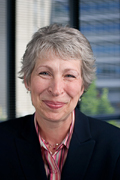 Haddad
Honored Haddad
Honored
Amy Haddad, Ph.D., director of the Center for Health Policy
and Ethics at Creighton University Medical Center, was recognized
during a June 12 Tribute to Women luncheon, one of Omaha’s
largest events focused on increasing awareness of the tremendous
contributions women make in the community. Haddad was recognized
for her efforts in the medical professions. The event is a
fundraiser for the YWCA in Omaha.
Faculty Recognized at Spring
Meeting
Four Creighton faculty members were recognized during the
School of Medicine’s spring faculty meeting. Receiving
awards were:
- Distinguished
Continuing Medical Education Faculty Award. John
Bertoni, M.D. professor and chair of the Department of Neurology
and director of Creighton’s Movement Disorders Clinic
- Distinguished
Service Award. Joseph Lynch, M.D., associate professor
in the Department of Medicine
- Dedicated
Teacher Award. Mark Goodman, M.D., assistant professor
in the Department of Family Medicine
- Outstanding
Mentor Award. Bernd Fritzsch, Ph.D., professor
in the Department of Biomedical Sciences
Back
to Contents
Faculty
News
Arrivals
- Xian-Ming Chen,
M.D., Department of Medical Microbiology & Immunology,
associate professor
- Attila Csordas,
M.D., Department of Radiology, assistant professor
- Caishu Deng,
M.D., Department of Pathology, assistant professor
- Olaf Kaufman,
M.D., Ph.D., Department of Radiology, instructor
- Hina Naushad,
M.B.B.S., Department of Pathology, assistant professor
Departures
- Preema Rapuri,
Ph.D., Department of Medicine
- Peter Canaday,
M.D., Department of Radiology
- Ward Pedersen,
Ph.D., Department of Pathology
- Judith Bell,
Ed.D., Department of Family Medicine
- Matthew Omojola,
M.B.B.S., Department of Radiology
- Robert Bonebrake,
M.D., Department of Obstetrics/Gynecology
Promotion
and Tenure
- David Z.Z. He,
Ph.D., professor of biomedical science
- Sade Kosoko-Lasaki,
M.D., professor of surgery
- Peter Silberstein,
M.D., associate professor of medicine
- Jeffrey Stokes,
M.D., associate professor of medicine
Promotion
- Diane Cullen,
Ph.D., professor of medicine and biomedical sciences
- Michael Davidian,
M.D., associate professor of medicine
- Ray Gaines,
M.D., professor of surgery
- Richard Hallworth,
Ph.D., professor of biomedical sciences
- Claire Hunter,
M.D., associate professor of medicine
- Brian Loggie,
M.D., professor of surgery
- Sandor Lovas,
Ph.D., professor of biomedical sciences
- Anna Maio,
M.D., associate professor of medicine
- Matthew Omojola,
M.D., professor of radiology
- Henry Sakowski,
M.D., associate professor of medicine
- Terry Zach,
M.D., professor of pediatrics
Tenure
- Richard Baltaro,
M.D., associate professor of pathology
- Zoran Gatalica,
M.D., professor of pathology
- Frederick Petty,
M.D., Ph.D., professor of psychiatry
Back
to Contents
|

